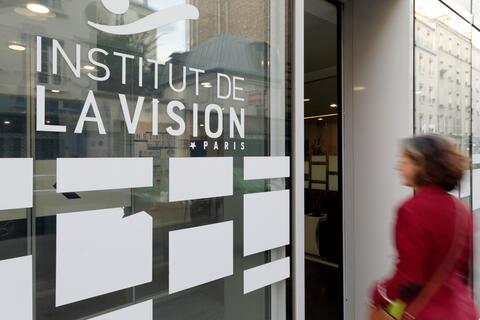
Identification of a new gene associated with genetic retinal dystrophies
At the Vision Institute, the team led by Christina Zeitz and Isabelle Audo is seeking to identify the genetic defects responsible for inherited retinal diseases and to develop innovative gene therapies.

Their team recently discovered mutations in a new gene in four patients suffering from this type of pathology.
Can you explain what retinal dystrophies of genetic origin are and why they represent a major medical challenge?
Isabelle Audo: Genetic retinal dystrophies (GRDs) are a group of genetically heterogeneous diseases with limited therapeutic options. In most cases, these rare diseases are progressive and degenerative, leading to visual impairment and even blindness in the most severe forms.
Christina Zeitz: If we are ever to offer patients innovative treatments to halt the disease or restore their vision, it is essential to gain a better understanding not only of the mechanisms that lead to this degeneration, but also of the genes associated with these diseases, many of which are still unknown.
What were the main challenges you encountered during your research?
C. Z.: In this study, we focused on the most common rare disease of the retina: retinopathy pigmentosa. We identified the role of the UBAP1L gene, whose mutations represent a potential cause of DRG.
I. A.: Determining which variant causes the disease is like looking for a needle in a haystack, because we have thousands of variants in our genome. Once found, the next step is to verify that the mutated gene in question is really responsible for the pathology. To do this, we need a large enough cohort to validate our results by identifying other cases.
Why did you choose to use both induced pluripotent stem cells and zebrafish in your study?
C. Z.: To model the disease and validate the role of this new gene in the retina, we used both approaches because, experimentally speaking, it's essential not to settle for a single model.
I. A.: Induced pluripotent stem cells derived from retinal cells have the advantage of containing the patient's entire genomic environment. But this system remains artificial. On the other hand, the zebrafish model, which has very large retinas, remains a complete animal model, even if it is phylogenetically distant from man. These two models are therefore complementary when it comes to testing new therapies.
How do mutations in the UBAP1L gene affect retinal photoreceptors?
C. Z.: What we know is that the UBAP1L gene codes for a protein associated with a small molecule called ubiquitin, which is involved in the elimination of abnormal proteins and is essential for cell function. We therefore hypothesize that a mutation in this gene could lead to a problem in the quality control of the production of certain proteins in the retina.
I. A.: In effect, a poorly formed protein that is not eliminated generates errors in the cell's metabolism, which can lead to degeneration of the photoreceptors, the light-sensitive cells.
What are your next research objectives following this discovery?
I. A.: In our team, we have already identified the genetic cause of around 70% of DRG cases. While there are still many genes to be discovered, the mutations we have just identified in the UBAP1L gene are a further step forward in this highly competitive field of research. One of our PhD students will devote her thesis to this gene, in an attempt to gain a better understanding of its metabolic pathways. Her study in other cohorts will enable us to determine the prevalence of the genetic defect and its geographical distribution.
C. Z.: This discovery is also a new therapeutic target: it concerns a particular biochemical pathway, linked to the control of protein synthesis in the cell and protection against oxidative stress. If we can specifically target this pathway, we may have therapeutic hope for patients suffering from retinopathy pigmentosa.
How is the Institut de la Vision's environment conducive to the development of this type of research?
I. A. : This institute enables us to forge collaborations without which we would not have been able to develop our models. Our team is an expert in the search for genetic defects in DRGs using high-throughput sequencing, but we wouldn't have made any progress without the help of Olivier Goureau, who drew up the protocols for induced pluripotent cell modeling, Filippo Del Bene who developed the zebrafish model, and the platforms made available at the institute.
C. Z.: We are also fortunate to have nearly 10,000 patients referenced in our 15-20 rare disease reference center, four of whom enabled us to identify this gene in a cohort of over 4,000 subjects. Each patient is a building block in our research. And even if they don't benefit directly from research advances, they will certainly benefit indirectly one day.
Study reference: Christina Zeitz et al.Variants in UBAP1L lead to autosomal recessive rod-cone and cone-rod dystrophy, revue Genetics in Medicine, 2024I
Isabelle Audo, Knight in the Order of the Legion of Honor
Researcher in ophthalmology, university professor and hospital practitioner at Sorbonne University and deputy director of the Vision Institute, Isabelle Audo was awarded the insignia of Chevalier dans l'ordre national de la légion d'honneur by Professor José-Alain Sahel on March 26, 2024. "This distinction also goes to all the people who have supported me since the start of my studies and helped me set up my projects. In medicine, as in research, you don't work alone. Today, I hope that this distinction will give us additional impetus to continue to go further in the genetic discoveries of these rare retinal diseases", concludes Isabelle Audo.

